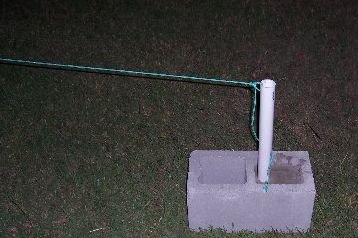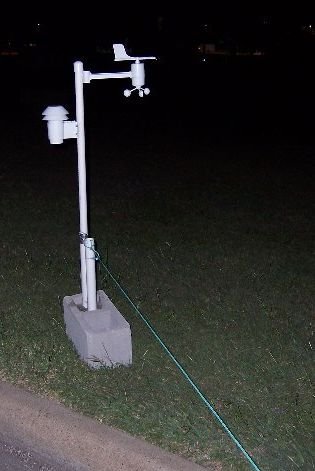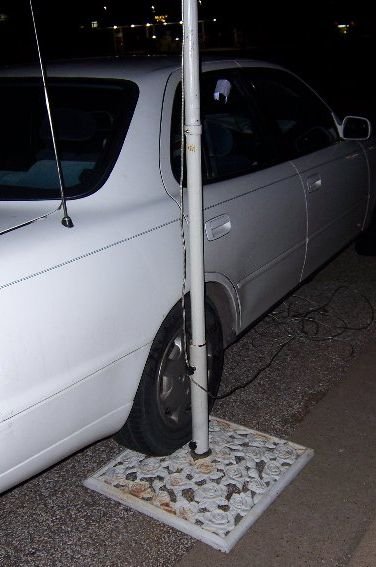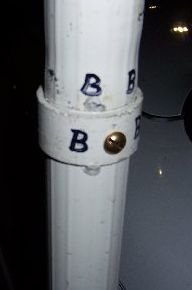A Short Note On Hurricane IKE
de Bob Hejl W2IK – NNN0KSI – NNN0GBY2 Ecom STX
One of the advantages of preparing for a hurricane is that it may take a few days before it “concerns” your area. As the projected path of hurricane IKE became more focused on the Texas Gulf coast area, it became evident that I might be called upon to deploy as a MARS Ecom station to report conditions at whatever location I might find myself. I was, of course, going to use my station with one of my NVIS antennas due to it’s ability of having lower noise floor reception and wouldn’t be prone to too much of an increase in “static crashes” caused by distant lightening.
The Problem I began to think that if the ground were to become too saturated due to intense rains it might undermine my standard ground-stake support system.http://www.armymars.net/ArmyMARS/EmergencyOps/w2ik/w2ik%20archive/hometown.aol.com/alonestaryank/ENVISANT.html I do most of my best thinking when I am either in the “Reading Room” or in bed, so I laid in my bed and it came to me….. a way of supporting my NVIS antenna in weather not prime for ground stakes. Not only would I be able to use this support system in saturated soil, but ALSO if I had to set up an antenna on a paved surface.
 The Solution…
The Solution…
End supports each with a short PVC pipe cemented in cider-blocks with hydraulic cement. I’d also make one with an additional pipe to support my wireless weather reporting units.

Since my simple NVIS antenna offers little wind-load, it seemed the perfect answer. Just one additional thought, when deploying the antenna the blocks should face with the long side running with that of the antenna so any pull will not tip the blocks.
I made my new mounts and as you can see below I used them to deploy during hurricane IKE. These are actual deployment pictures taken before the storm hit.

 The center of this antenna was made from just two sections of aluminum military masting with a bolt to hold the sections in place.
The center of this antenna was made from just two sections of aluminum military masting with a bolt to hold the sections in place.
The masting was secured to a heavy-duty cast-iron umbrella mount secured with one of the rear wheels of my car. See below:
When it became evident that I’d have to deploy, I drove in a semi-circle to reach my deployment location (to avoid evac routes and support traffic). Since it was determined that the hurricane would track in a direction more northerly once it made landfall in the Houston area I deployed along it’s would-be path about 60 miles NE of the city.
After driving over 145 miles from my home, I ended up in Brenham, Texas in Washington County. Sometimes you tend to over-think a deployment and it can bite you in the ass. This time, it did just that.
The Location One of the best locations to set up is usually in the parking lot of a Walmart Super-Center because they allow overnight parking of campers and truckers and since the store is always open, you have use of their “facilities”.
 Well, not this time! As you can see below, the store closed at 6PM on Friday with them creating a barrier against projectile damage to their doors. It’s also a good idea to be in a location such as this because you are less prone to trees falling as long as you park in the clear.
Well, not this time! As you can see below, the store closed at 6PM on Friday with them creating a barrier against projectile damage to their doors. It’s also a good idea to be in a location such as this because you are less prone to trees falling as long as you park in the clear.
There were dozens of truckers and evacuees from Houston hoping to ride out the storm there. Many had campers and even offered the use of their own “facilities” if I needed them. It’s always nice to see people willing to go out of their way to assist others during events such as hurricanes.Although we didn’t get as nearly as intense wind forces as were experienced at the coast (top gusts at this location were about 65 mph), we experienced quite a bit of the product of this hurricane in the form of constant wind and horizontal rain.
During the Storm I remained safe on my car and gave half- hourly weather reports and visual observations to an emergency MARS net established for this very purpose. My reports were sent to such agencies as FEMA, DOD and Homeland Security so they could see the development of the storm along it’s path. You could easily tell the storm was bearing down as the barometric pressure steadily dropped during it’s approach and the average wind speed increased with each report.I never worried about either my safety and my antenna system never budged. From an operational standpoint, it was a good deployment. I was kept busy with my communications duties which was a joint effort by all three MARS services. We only lost local power for a short time. My equipment, rigs and led lighting system ran well using three sets of deep-cycle marine batteries.
Heading Home I was done with my deployment/reporting duties late Saturday and a quick breakdown had me on the road in little time. There was minor flooding and minor damage to the scale that it wasn’t worthy of taking pictures and I was too tired to stop and take any. The only worry that I had to concern myself with was over-road flooding of the many creeks and streams I had to drive over. None created a problem. I do know that a few of my fellow MARS ops who lived in that area suffered loss of power and in one case roof damage.
I regret that I couldn’t post a picture of my messy/cramped operating station in my car but the picture shows my rig’s frequency display set on a MARS classified frequency.
Walmart never did re-open during my stay.
�
